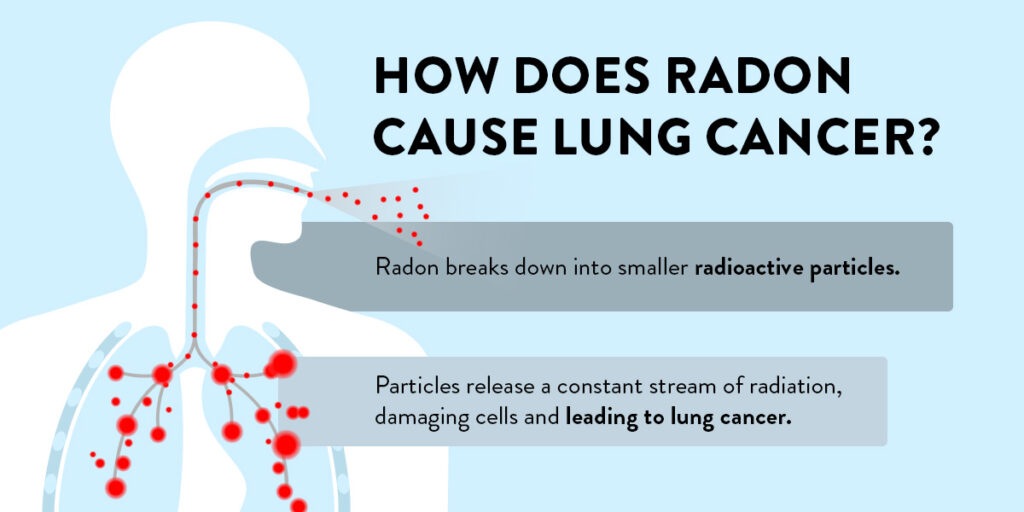Smoking is one of the leading causes of lung cancer, but people often think that they can’t get lung cancer if they don’t smoke. Sadly, this isn’t true, and there are many misconceptions around it. In this article, we’ll discuss the top secondary cause and how you can protect yourself and your family.
Can You Get Lung Cancer Without Smoking?
Yes, you can get lung cancer without smoking. While smoking involves consistent exposure to a damaging substance, many other things can cause cancer as well.
It’s worth noting that, while vaping is considered safer than smoking traditional cigarettes, pipes or cigars, it also exposes your lungs to carcinogens. Studies are still underway to determine the extent of the risks involved.
Types of Lung Cancer in Nonsmokers
Up to 60% of cancers among nonsmokers are adenocarcinomas — cancers that originate in glandular cells — making them the most common lung cancer in nonsmokers. The next most common is squamous cell carcinomas, up to 20%. In a nonsmoker, small-cell lung cancers comprise up to 8% of cancer cases.
Nonsmokers may be diagnosed with other types of cancers as well, but they’re less common.
How Common Is Lung Cancer in Nonsmokers?
In the United States, between 10% and 20% of all lung cancer diagnoses are for nonsmokers. This means between 20,000 and 40,000 annual cases of lung cancer happen to people who have never smoked.
Many secondary factors may increase the risk of lung cancer in nonsmokers, including:
- Predisposition: Some families are genetically inclined toward cancer susceptibility, making their members more likely to develop lung cancers and other such conditions.
- Exposure: Anyone who is regularly exposed to carcinogens (cancer-causing substances) is susceptible to various kinds of cancer, including lung cancer.
- Diet: Certain dietary choices can degrade the immune system and expose consumers to additional carcinogens, increasing their risk of developing cancer.
Because it’s such a widespread concern, organizations like the American Lung Association host several awareness campaigns every year. November is Lung Cancer Awareness Month, and August 1 is World Lung Cancer Day.
Both campaigns educate the public about lung cancer and the risks of smoking and other causes, like radon exposure.
What Causes Lung Cancer in Nonsmokers?
Nonsmokers may develop lung cancer due to factors like:
- Air pollution
- Radon exposure
- Secondhand smoke inhalation
- Occupational exposure
- Genetic mutations
- Asbestos exposure
Of course, radiation exposure can also cause several other types of cancer.
Radon is the leading cause of lung cancer in nonsmokers and can also contribute to lung cancer in smokers. An estimated 21,000 annual lung cancer deaths in the U.S. are radon-related, making this gas a significant cause for concern.
What Is Radon?
Radon is a natural gas that occurs when uranium breaks down in the soil. It’s more common in some regions, where the uranium concentrations in the soil are naturally higher. Over time, radon gas breaks down further into microscopic radioactive particles known as radon progeny.
Why Is Radon So Dangerous?
There are several reasons why radon can be a devastating cause of lung cancer, but the main reason is that it’s nearly impossible to detect without specific testing.
This gas is naturally occurring anywhere you find uranium in the soil, which means it could be anywhere. Furthermore, it’s odorless, colorless, tasteless and completely invisible, which means you don’t know to look for it. Combined with the fact that it damages respiratory systems and causes lung cancer, it becomes a lethal enemy.
According to the North Carolina Department of Health and Human Services, if 1,000 nonsmokers were exposed to a radon level of 4 picocuries per liter, around seven would develop lung cancer. For former smokers, the risk is higher, with around 62 people developing lung cancer at the same concentration.
How Does Radon Cause Lung Cancer?

Radon breaks down into smaller radioactive particles. When you inhale radon particles, they can become trapped in the linings of your lungs, where they break down further. As they decompose within your lungs, these radon particles release a constant stream of radiation, damaging cells and leading to lung cancer.
It’s important to note that exposure to both radon and cigarette smoke significantly increases your chances of contracting lung cancer.
How Do People Get Exposed to Radon?
People may get exposed to radon in various ways and places, including the following:
At Home
Throughout the U.S., around one in every 15 homes has elevated radon levels. Unfortunately, most homeowners don’t even realize that their homes have higher-than-usual radon levels.
Elevated radon levels are fairly common in several states, including:
- Colorado
- Iowa
- Pennsylvania
- South Dakota
- Montana
- Kentucky
If you live in any of these areas, or another region where higher radon levels are common, you may be at risk of exposure.
At Work or Public Spaces
Like homes in regions with heightened radon levels, office buildings and other public spaces in these locations are also at risk. Even if you live in an area that doesn’t typically have elevated radon levels, but work in a region with higher levels, you may still be experiencing radon exposure.
Radon may infiltrate any home or building through various means, including:
- Cracks in the floors and foundations
- Joints in the building construction
- Floor drains and low vents
When water comes into contact with radon-releasing materials, the water can also absorb radon. The most extreme exposure to radon, however, is through buildups occurring in basements, crawl spaces and other areas before infiltrating living spaces.
Symptoms of Lung Cancer in Nonsmokers
Whether you’re a smoker or not, lung cancer generally causes some fairly consistent symptoms, including:
- Constant fatigue
- Feeling generally unwell
- Frequent coughing or wheezing
- Coughing up blood
- Chest pain
- Shortness of breath
- Loss of appetite
- Recurrent respiratory problems or infections
- Trouble swallowing
- Weight loss
While these symptoms could indicate lung cancer, they’re not unique to lung cancer. If you experience one or several of these symptoms, consult a physician.
In some cases, lung cancer may also be relatively asymptomatic, which means it can develop without any significant symptoms.
How to Avoid Radon Exposure
Since it’s one of the leading causes of lung cancer, minimizing your exposure to radon is essential to protect yourself and your family. However, as mentioned above, it’s impossible to detect without testing.
Regular radon testing — and professional mitigation, if necessary — can help protect your family’s health and safety. Order your radon testing kit today and find out whether your home has elevated radon levels. SWAT Environmental can help you interpret your test results and determine an appropriate mitigation solution if you need one.


